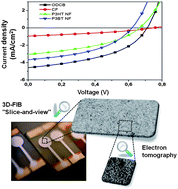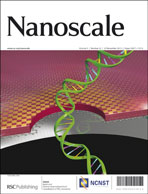Multiscale tomographic analysis of polymer–nanoparticle hybrid materials for solar cells†
Abstract
The present work focuses on the study of the three-dimensional (3D) morphology of polymer and nanoparticle hybrid nanocomposites used as active layers in solution-processed solar cells. The hybrid consists of blends of regioregular poly(3-alkylthiophene) and CdSe nanorods. Electron tomography (ET) analysis performed in high-angle annular dark-field scanning transmission electron microscopy (HAADF-STEM) allows resolving single nanorods in the hybrid blend. These results are compared with those obtained using focused ion beam coupled with scanning electron microscopy (FIB-SEM), operated in a so-called 3D “slice-and-view” mode. This technique allows 3D information to be obtained on a whole device stack (hybrid active layers plus electrodes and the substrate) for significantly larger surface areas than with ET (∼10 vs. ∼0.1 μm2). The combination of ET and 3D FIB “slice-and-view” reconstructions provides complementary and coherent information on the 3D morphology of the hybrid systems at different length scales. Phase separation between the nanoparticles and the polymer is investigated by a quantitative analysis of the reconstructed volumes and is related to the performances of the hybrid devices.


 Please wait while we load your content...
Please wait while we load your content...